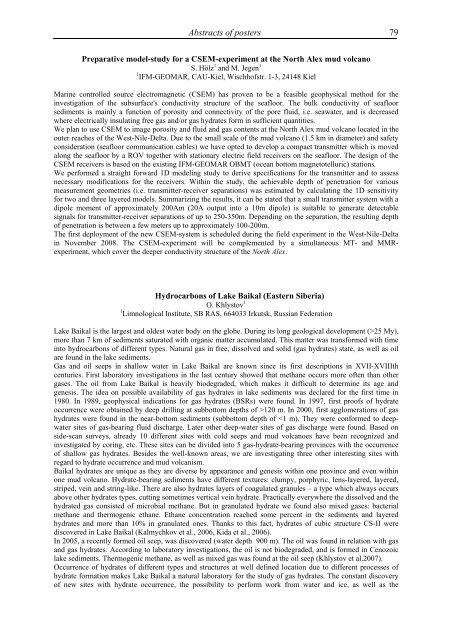Ninth international conference on - Marum
Ninth international conference on - Marum
Ninth international conference on - Marum
You also want an ePaper? Increase the reach of your titles
YUMPU automatically turns print PDFs into web optimized ePapers that Google loves.
Abstracts of posters 79<br />
Preparative model-study for a CSEM-experiment at the North Alex mud volcano<br />
S. Hölz 1 and M. Jegen 1<br />
1 IFM-GEOMAR, CAU-Kiel, Wischhofstr. 1-3, 24148 Kiel<br />
Marine c<strong>on</strong>trolled source electromagnetic (CSEM) has proven to be a feasible geophysical method for the<br />
investigati<strong>on</strong> of the subsurface's c<strong>on</strong>ductivity structure of the seafloor. The bulk c<strong>on</strong>ductivity of seafloor<br />
sediments is mainly a functi<strong>on</strong> of porosity and c<strong>on</strong>nectivity of the pore fluid, i.e. seawater, and is decreased<br />
where electrically insulating free gas and/or gas hydrates form in sufficient quantities.<br />
We plan to use CSEM to image porosity and fluid and gas c<strong>on</strong>tents at the North Alex mud volcano located in the<br />
outer reaches of the West-Nile-Delta. Due to the small scale of the mud volcano (1.5 km in diameter) and safety<br />
c<strong>on</strong>siderati<strong>on</strong> (seafloor communicati<strong>on</strong> cables) we have opted to develop a compact transmitter which is moved<br />
al<strong>on</strong>g the seafloor by a ROV together with stati<strong>on</strong>ary electric field receivers <strong>on</strong> the seafloor. The design of the<br />
CSEM receivers is based <strong>on</strong> the existing IFM-GEOMAR OBMT (ocean bottom magnetotelluric) stati<strong>on</strong>s.<br />
We performed a straight forward 1D modeling study to derive specificati<strong>on</strong>s for the transmitter and to assess<br />
necessary modificati<strong>on</strong>s for the receivers. Within the study, the achievable depth of penetrati<strong>on</strong> for various<br />
measurement geometries (i.e. transmitter-receiver separati<strong>on</strong>s) was estimated by calculating the 1D sensitivity<br />
for two and three layered models. Summarizing the results, it can be stated that a small transmitter system with a<br />
dipole moment of approximately 200Am (20A output into a 10m dipole) is suitable to generate detectable<br />
signals for transmitter-receiver separati<strong>on</strong>s of up to 250-350m. Depending <strong>on</strong> the separati<strong>on</strong>, the resulting depth<br />
of penetrati<strong>on</strong> is between a few meters up to approximately 100-200m.<br />
The first deployment of the new CSEM-system is scheduled during the field experiment in the West-Nile-Delta<br />
in November 2008. The CSEM-experiment will be complemented by a simultaneous MT- and MMRexperiment,<br />
which cover the deeper c<strong>on</strong>ductivity structure of the North Alex.<br />
Hydrocarb<strong>on</strong>s of Lake Baikal (Eastern Siberia)<br />
O. Khlystov 1<br />
1 Limnological Institute, SB RAS, 664033 Irkutsk, Russian Federati<strong>on</strong><br />
Lake Baikal is the largest and oldest water body <strong>on</strong> the globe. During its l<strong>on</strong>g geological development (>25 My),<br />
more than 7 km of sediments saturated with organic matter accumulated. This matter was transformed with time<br />
into hydrocarb<strong>on</strong>s of different types. Natural gas in free, dissolved and solid (gas hydrates) state, as well as oil<br />
are found in the lake sediments.<br />
Gas and oil seeps in shallow water in Lake Baikal are known since its first descripti<strong>on</strong>s in XVII-XVIIIth<br />
centuries. First laboratory investigati<strong>on</strong>s in the last century showed that methane occurs more often than other<br />
gases. The oil from Lake Baikal is heavily biodegraded, which makes it difficult to determine its age and<br />
genesis. The idea <strong>on</strong> possible availability of gas hydrates in lake sediments was declared for the first time in<br />
1980. In 1989, geophysical indicati<strong>on</strong>s for gas hydrates (BSRs) were found. In 1997, first proofs of hydrate<br />
occurrence were obtained by deep drilling at subbottom depths of >120 m. In 2000, first agglomerati<strong>on</strong>s of gas<br />
hydrates were found in the near-bottom sediments (subbottom depth of














